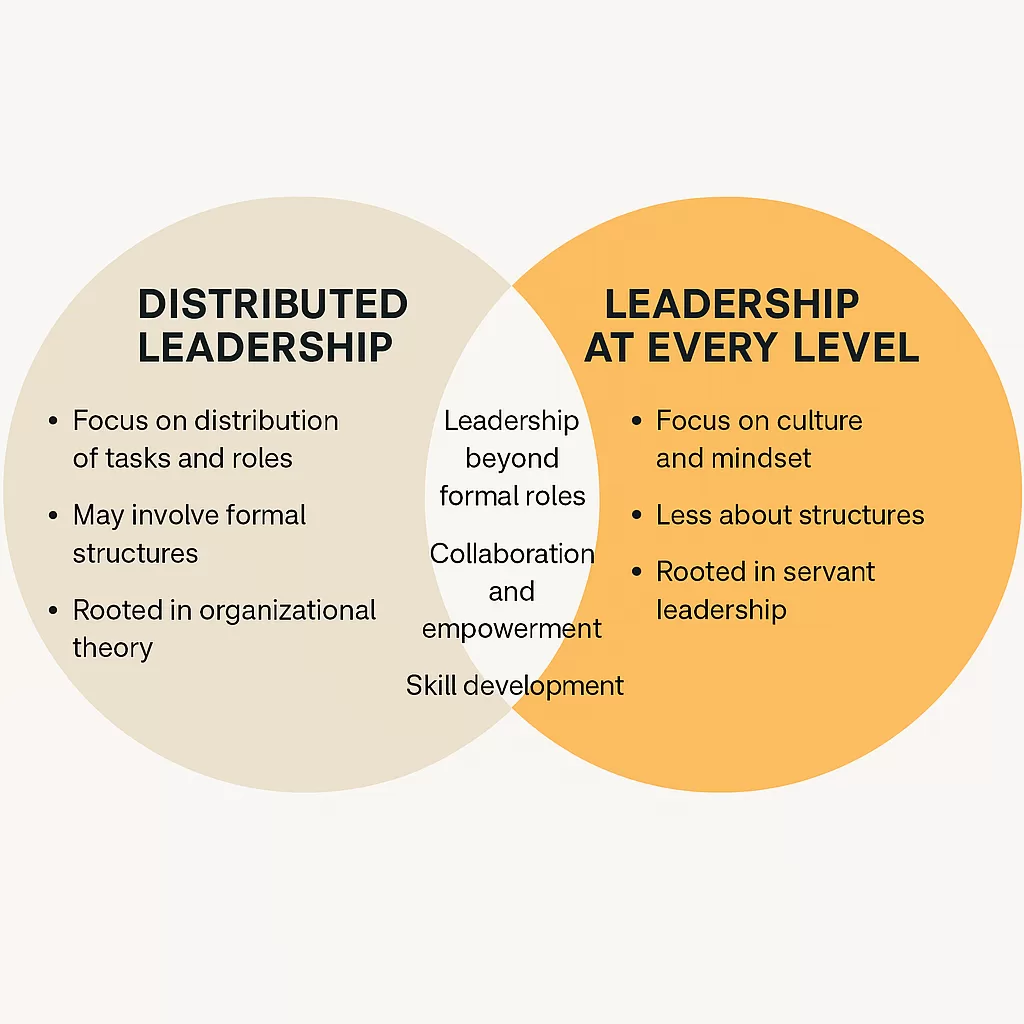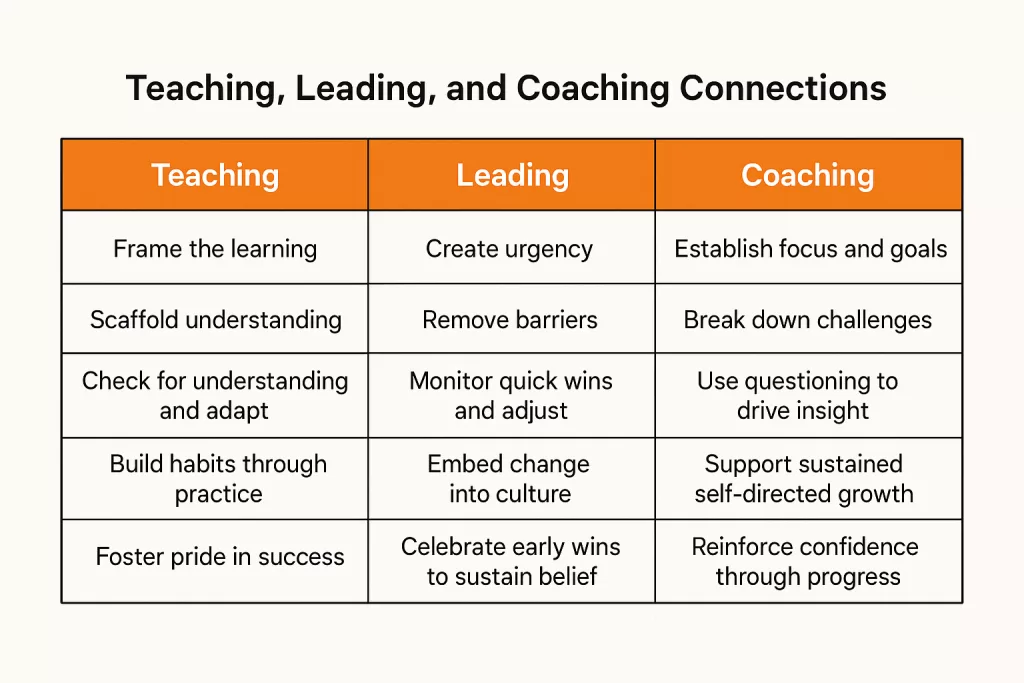Few concepts in school leadership provoke as much quiet scepticism as distributed leadership. For many teachers, the idea that “everyone leads” feels less like empowerment and more like exploitation — a way for senior leaders to offload initiatives without proper recognition, reward, or respect. It is seen, often correctly, as aping corporate jargon: a glossy label for asking the most ambitious and capable staff to carry extra burdens. Such mistrust is not unfounded, and any honest discussion about leadership in schools must begin by acknowledging these concerns.
Yet beneath the poor implementations and hollow slogans, there remains a valuable idea worth rescuing: the fostering of leadership attributes among teachers. Not in the service of overloading them with others’ work, but as part of helping them grow in confidence, autonomy, and influence within the school community.
So perhaps it is not distributed leadership that deserves our attention, but rather the deeper recognition that leadership — thoughtfully nurtured — is already part of what many teachers do, and could become even stronger with support.
Leadership in Every Role
When I worked in United Learning, the UK’s largest multi-academy trust, their Framework for Excellence fostered leadership in every role, which they defined as the daily act of setting direction and expectation through words, tone, and actions, and taking responsibility and initiative to do what is right for the children.
Both distributed leadership and leadership in every role (or leadership at every level, as it is sometimes referred to) are founded on the belief that leadership should not be the preserve of the few, but rather the shared responsibility of all. Each approach values empowerment, collaboration, and the broad cultivation of leadership skills across an organisation.
However, distributed leadership tends to formalise this sharing of power, mapping leadership roles and tasks onto a structure, often with clear delegation and accountability. In contrast, leadership in every role is less about structures and more about fostering a culture where anyone, regardless of position, is encouraged to lead when the situation demands it. Distributed leadership can, and often does, become a bureaucratic exercise — well-intentioned but ultimately hollow — whereas leadership in every role refers to cultural changes and aims to build leadership capacity organically rather than administratively.

Those familiar with Rosenshine’s Principles of Instruction will already recognise how effective teaching is built not just on what is taught, but how it is introduced, reinforced, and embedded.
But what’s striking, when viewed through a wider lens, is how much the best evidence about classroom teaching overlaps with the best evidence about leading organisational change.
Take John Kotter’s 8-Step Change Model, for example. Designed to help leaders guide organisations through transformation, Kotter’s steps mirror many of the same cognitive and emotional processes that underpin effective learning — and effective coaching.
Here’s how Kotter’s change model maps against Rosenshine’s principles of good teaching:
| Kotter’s Change Step | Rosenshine’s Classroom Principle | Shared Idea |
| Create a sense of urgency | Begin a lesson with a short review to spark focus | Attention and motivation must be captured early. |
| Build a guiding coalition | Provide guided practice with support | Early structure and shared goals matter. |
| Form a strategic vision | Present material in small steps with clarity | Simplicity and coherence reduce overload. |
| Enlist a volunteer army | Engage students through active questioning | Active participation sustains commitment. |
| Remove barriers to action | Provide scaffolds to support learning | Lower obstacles, support early success. |
| Generate short-term wins | Check for understanding and celebrate progress | Early success builds belief and momentum. |
| Sustain acceleration | Conduct regular reviews and practice retrieval | Reinforcement prevents decay. |
| Institute change (embed it in culture) | Develop automaticity through repeated practice | Mastery becomes part of the classroom culture. |
What This Means for Teachers and School Leaders
- Change leadership and classroom practice should feel aligned. Teaching isn’t just about content delivery, just as leadership isn’t about issuing commands. Both are about guiding journeys — with clarity, scaffolding, feedback, and celebration.
- Habits and routines are the foundation of both lasting learning and lasting change. Whether you’re building retrieval practice into your lessons or shifting a school’s culture, what happens once must happen again and again until it becomes the new normal.
- Motivation must be nurtured, not assumed. Students, like staff, don’t automatically stay motivated. Early wins, clear pathways, and visible progress matter enormously.
- Good teaching and good leadership both rely on creating psychological safety. Students take risks when they feel safe to fail. Staff adopt new practices when they trust the environment.
When we see teaching and leading as parallel processes, we lead better and teach better.
In the classroom, we create conditions for students to grow — not by overwhelming them with information, but by guiding their journey: step-by-step, with support, clarity, and encouragement.
In leadership, we create conditions for change — not by commanding transformation, but by building coalitions, scaffolding action, celebrating wins, and embedding success.
In both cases, we are not just delivering content or giving instructions. We are helping people think differently, build confidence, and achieve lasting growth.
So what about the coaching bit?
At its heart, coaching builds the bridge between teaching and leading.
The skills that underpin coaching — listening carefully, asking purposeful questions, providing supportive challenge, helping others find their own solutions — are the very same skills that drive effective learning and sustainable change.
Coaching principles applied to teaching and leading include:
- Establishing clarity and focus (What are we trying to achieve?)
- Breaking down complexity (What’s the first step?)
- Creating psychological safety (It’s okay not to know — this is where growth happens)
- Building ownership and autonomy (You find your way forward, with support.)
- Celebrating reflection and iteration (Learning and change are ongoing processes.)
In teaching, these skills help students take ownership of their learning. In leadership, they help teams take ownership of their growth and change. In both, they turn compliance into commitment — and surface-level participation into deep engagement.

In Closing
When we see teaching, leading, and coaching as connected practices, we unlock better ways to support students, colleagues, and organisations.
At their best, teaching, leading, and coaching are not about comand and control — they are about creating the right conditions for people to think clearly, grow steadily, and achieve more.
Schools often talk about the need for more TLC. In this context, that means more than just tender loving care. It means Teaching, Leading, and Coaching that focus on clarity, purpose, and practical support for learning and improvement in every role.
References and Further Reading
Kotter, J.P., 1996. Leading Change. Boston: Harvard Business Review Press.
Rosenshine, B., 2012. Principles of Instruction: Research-Based Strategies That All Teachers Should Know. American Educator, [online] 36(1), pp.12–19. Available at: https://www.aft.org/sites/default/files/periodicals/Rosenshine.pdf [Accessed 14 April 2025].
United Learning, 2025. Framework for Excellence. [online] United Learning. Available at: https://unitedlearning.org.uk/about-us/framework-for-excellence [Accessed 14 April 2025].
Whitmore, J. (2017) Coaching for Performance: The Principles and Practice of Coaching and Leadership. 5th ed. London: Nicholas Brealey Publishing.
“To unlock potential, we must first create the conditions in which people feel safe enough to explore it.“
John Whitmore
Subscribe to our newsletter
- Actionable insights on leadership, learning, and organisational improvement
- Thought-provoking reflections drawn from real-world experience in schools and beyond
- Curated resources on effective practice and digital strategy
- Early access to new articles, events, and consultancy updates
- Invitations to subscriber-only webinars, Q&As, and informal conversations
- Clarity, not clutter—you will not be bombarded by emails
Cancel or pause anytime.

Leave a Reply